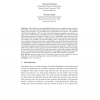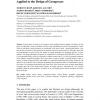241 search results - page 33 / 49 » Understanding Social Networks Using Formal Concept Analysis |
CMOT
2004
13 years 7 months ago
2004
Social action is situated in fields that are simultaneously composed of interpersonal ties and relations among organizations, which are both usefully characterized as social netwo...
BMCBI
2006
13 years 7 months ago
2006
Background: The analysis of biochemical networks using a logical (Boolean) description is an important approach in Systems Biology. Recently, new methods have been proposed to ana...
JUCS
2006
13 years 7 months ago
2006
: The need for processing biological information is rapidly growing, owing to the masses of new information in digital form being produced at this time. Old methodologies for proce...
ATAL
2006
Springer
13 years 11 months ago
2006
Springer
We study how decentralized agents can develop a shared vocabulary without global coordination. Answering this question can help us understand the emergence of many communication s...
CSCW
2002
ACM
13 years 7 months ago
2002
ACM
Activity theory is based on the concept of tools mediating between subjects and objects. In this theory, an individual's creative interaction with his or her surroundings can ...


